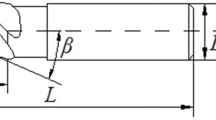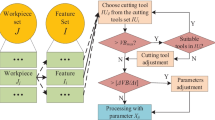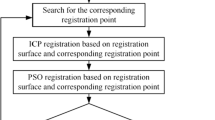Abstract
A blank dimension is not only a premise of blank design and manufacture, but also plays a significant role to decide the machining process and the energy consumption of the machining process. The design of an appropriate blank dimension is important to ensure efficient energy usage. However, consideration of a workpiece machining process and energy consumption during the machining process in the blank dimension design phase is often neglected. To design a blank dimension scientifically and effectively, this paper proposes an optimization approach for blank dimension design, by considering energy consumption, machine cost, and process time. The three objectives are affected by three variables, cutting depth, feed rate, and cutting speed. The non-dominated sorting genetic algorithm-II (NSGA-II) algorithm was used to solve multi-objective optimization problem, and blank dimensions could be calculated from the cutting depth of minimum energy consumption and workpiece dimension. The results indicated that the proposed approach is effective in realizing energy savings due to the appropriate blank dimension design. The optimization approach not only offers some insights for designing a new blank dimension, but also provides a theoretical basis for existing blank dimension selection.
Similar content being viewed by others
References
NBS (2010) China Energy Statistical Yearbook. China Statistics Press, Beijing
Dahmus J, Gutowski T (2004) An Environmental Analysis of Machining. Proceedings of ASME International Mechanical Engineering Congress and R&D Exposition, pp. 13–19
Joseph C, Taplin R (2011) The measurement of sustainability disclosure: abundance versus occurrence. Account Forum 35(1):19–31
Dornfeld DA (2014) Moving toward sustainable and green manufacturing. Int J Precis Eng Manuf-Green Technol 1(1):63–66
Dambhare SG, Deshmukh SJ, Borade AB (2015) Machining parameter optimization in turning process for sustainable manufacturing. Int J Ind Eng 6:27–338
Brodsky A, Shao G, Riddick F (2014) Process analytics formalism for decision guidance in sustainable manufacturing. J Intell Manuf. doi:10.1007/s10845-014-0892-9
Liu F, Sowerby R (1991) The determination of optimal blank shapes when deep drawing prismatic cups. J Mater Shap Technol 9(3):153–15
Park SH, Yoon JH, Yang DY, Kim YH (1999) Optimum blank design in sheet metal forming by the deformation path iteration method. Int J Mech Sci 41:1217–1232
Naceur H, Guo YQ, Batoz JL (2004) Blank optimization in sheet metal forming using an evolutionary algorithm. J Mater Process Technol 151:183–191
Vafaeesefat A (2008) Optimum blank shape design in sheet metal forming by boundary projection method. Int J Mater Form Suppl 1:189–192
Chamekh A, BenRhaiem S, Khaterchi H, BelHadjSalah H, Hambli R (2010) An optimization strategy based on a metamodel applied for the prediction of the initial blank shape in a deep drawing process. Int J Adv Manuf Technol 50:93–100
Liu Y, Chen W, Ding L, Wang X (2013) Response surface methodology based on support vector regression for polygon blank shape optimization design. Int J Adv Manuf Technol 66:1397–1405
Kitayama S, Saiky M, Kawamot K, Yamamichi K (2015) Multi-objective optimization of blank shape for deep drawing with variable blank holder force via sequential approximate optimization. Struct Multidiscip Optim. doi:10.1007/s00158-015-1293-1
Bhushan RK (2013) Optimization of cutting parameters for minimizing power consumption and maximizing tool life during machining of Al alloy SiC particle composites. J Clean Prod 39:242–254
Chapman PF (1974) Energy costs: a review of methods. Energ Policy 2(2):91–103
Ippolito R, De FA (1979) Energy savings by proper machine tool management. SME Technical Paper (Series) MM (MM79-38) SME, USA
Jain NK, Jain VK, Deb K (2007) Optimization of process parameters of mechanical type advanced machining processes using genetic algorithms. Int J Mach Tools Manuf 47(6):900–919
Diaz N, Redelsheimer E, Dornfeld D (2011) Energy consumption characterization and reduction strategies for milling machine tool use. Proceedings of the 18th CIRP International Conference on Life Cycle Engineering, Braunschweig, pp 263–267
Bi ZM, Wang L (2012) Optimization of machining processes from the perspective of energy consumption: a case study. J Manuf Syst 31:420–428
Mativenga PT, Rajemi MF (2011) Calculation of optimum cutting parameters based on minimum energy footprint. CIRP Ann Manuf Technol 60(1):149–152
Mori M, Fujishima M, Inamasu Y, Oda Y (2011) A study on energy efficiency improvement for machine tools. CIRP Ann Manuf Technol 60(1):145–148
Kant G, Sangwan KS (2014) Prediction and optimization of machining parameters for minimizing power consumption and surface roughness in machining. J Clean Prod 83:151–164
Wang Q, Liu F, Wang X (2014) Multi-objective optimization of machining parameters considering energy consumption. Int J Adv Manuf Technol 71(5-8):1133–1142
Li J-G, Lu Y, Zhao H, Li P, Yao Y-X (2014) Optimization of cutting parameters for energy saving. Int J Adv Manuf Technol 70:117–124
Li J, Yang X, Ren C, Chen G, Wang Y (2015) Multiobjective optimization of cutting parameters in Ti-6Al-4V milling process using nondominatedsorting genetic algorithm-II. Int J Adv Manuf Technol 76:941–953
Camposeco-Negrete C, Najera JDC, Miranda-Valenzuela JC (2015) Optimization of cutting parameters to minimize energy consumption during turning of AISI 1018 steel at constant material removal rate using robust design. Int J Adv Manuf Technol. doi:10.1007/s00170-015-7679-9
Wang X (2007) Machining process manual. China Machine Press, Beijing
Tian GD, Chu JW, Liu YM, Ke H, Zhao X, Xu G (2011) Expected energy analysis for industrial process planning problem with fuzzy. Comput Chem Eng 35(12):2905–2912
Zhang Y, Ge Y (2015) Method for process planning optimization with energy efficiency consideration. Int J Adv Manuf Technol 77:2197–2207
Yin R, Cao H, Li H, Sutherland JW (2014) A process planning method for reduced carbon emissions. Int J Comput Integr Manuf 27(12):1175–1186
Rajemi MF, Mativenga PT, Aramcharoen A (2010) Sustainable machining: selection of optimum turning conditions based on minimum energy considerations. J Clean Prod 18(10 –11):1059–1065
Liu S, Liu F, Xie J, Wang QL (2012) Energy forecasting method for CNC machine tool during its working time, Patent application no.201210131766.4, China
Kalpakjian S, Schmid SR (2006) Manufacturing engineering and technology: machining. Tsinghua University Press, Beijing
Yi Q, Li C, Tang Y, Chen X (2015) Multi-objective parameter optimization of CNC machining for low carbon manufacturing. J Clean Prod 95:256–264
Author information
Authors and Affiliations
Corresponding author
Rights and permissions
About this article
Cite this article
Xiao, Y., Zhang, H. & Jiang, Z. An approach for blank dimension design considering energy consumption. Int J Adv Manuf Technol 87, 1229–1235 (2016). https://doi.org/10.1007/s00170-015-8048-4
Received:
Accepted:
Published:
Issue Date:
DOI: https://doi.org/10.1007/s00170-015-8048-4




